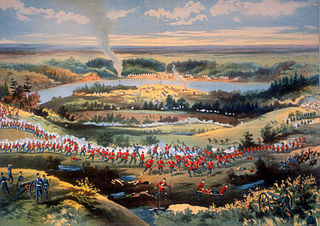
The North-West Rebellion, also known as the North-West Resistance, was an armed resistance movement by the Métis under Louis Riel and an associated uprising by First Nations Cree and Assiniboine of the District of Saskatchewan against the Canadian government. Many Métis felt that Canada was not protecting their rights, their land, and their survival as a distinct people.

The University of Saskatchewan is a Canadian public research university, founded on March 19, 1907, and located on the east side of the South Saskatchewan River in Saskatoon, Saskatchewan, Canada. An "Act to establish and incorporate a University for the Province of Saskatchewan" was passed by the provincial legislature in 1907. It established the provincial university on March 19, 1907 "for the purpose of providing facilities for higher education in all its branches and enabling all persons without regard to race, creed or religion to take the fullest advantage". The University of Saskatchewan is the largest education institution in the Canadian province of Saskatchewan. The University of Saskatchewan is one of Canada's top research universities and is a member of the U15 Group of Canadian Research Universities.
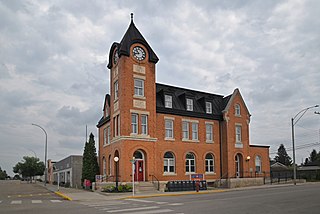
Battleford is a town located across the North Saskatchewan River from the City of North Battleford, in Saskatchewan, Canada.

Highway 5 is a major highway in the Canadian province of Saskatchewan. It begins in downtown Saskatoon and runs eastward to the Manitoba border near Togo, where it becomes Provincial Road 363. The highway is approximately 393 kilometres (244 mi) long. Between the early 1900s (decade) and 1976, Provincial Highway 5 was a trans-provincial highway travelling approximately 630 kilometres (390 mi) in length. At this time it started at the Alberta border in Lloydminster and traveled east to the Manitoba border.

Nutana is a primarily residential neighbourhood located near the centre of Saskatoon, Saskatchewan, Canada. It includes the business district of Broadway Avenue. It comprises a nearly even mixture of low-density, single detached dwellings and apartment-style multiple unit dwellings. As of 2009, the area is home to 6,261 residents. The neighbourhood is considered a middle to upper-income area, with an average family income of $67,657, an average dwelling value of $206,830 and a home ownership rate of 51.3%. First established in 1883, Nutana was the original settlement of what now makes up the city of Saskatoon.

Varsity View is a mostly residential neighbourhood located near central Saskatoon, Saskatchewan, Canada. It is immediately south of the University of Saskatchewan campus. It is an older suburban subdivision, comprising a mixture of low-density, single detached dwellings, detached duplexes and apartment-style units. As of 2007, the area is home to 3,611 residents. The neighbourhood is considered a middle-income area, with an average family income of $50,587, an average dwelling value of $284,710 and a home ownership rate of 38.7%. Its proximity to the university gives this area its relatively high student population, almost 25% in 2005.
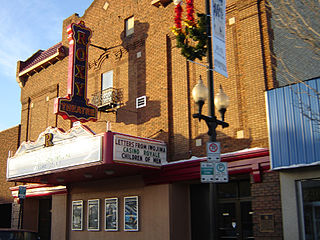
Riversdale is one of the oldest neighbourhoods in Saskatoon, Saskatchewan, Canada, located near the downtown area. It includes the business district of 20th Street. It consists mostly of low-density, single detached dwellings. As of 2021, the area was home to 2,534 residents.

City Park is a mixed-use neighbourhood located near the center of Saskatoon, Saskatchewan, Canada. It comprises a mix of single-family detached homes, apartment buildings and other semi-detached dwellings. It also contains a number of commercial zones with businesses. As of 2009, the area was home to 4,405 residents. The neighbourhood is considered a middle-income area, with an average family income of $42,236, an average dwelling value of $245,254 and a home ownership rate of 28.6%.

Harris is a village in the Canadian province of Saskatchewan within the Rural Municipality of Harris No. 316 and Census Division No. 12. It was the site of the Great Ruby Hoax in 1914. Harris was named for Richard Elford Harris, an early settler to the area.
There are numerous heritages and cultural attractions in the province of Saskatchewan. Museums, dinosaur digs, aboriginal cultural and heritage sites, art galleries, professional sport venues, spas, handcraft, antique and tea shops, agricultural tours, theatre and archaeological sites comprise over 600 varied Saskatchewan institutions.
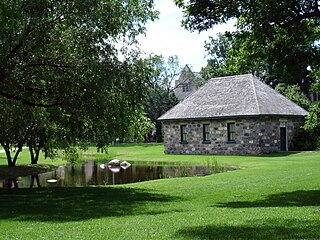
Victoria School is the name given to three public schools in Saskatoon, Saskatchewan, Canada, one of which was the first permanent school constructed in the city.

U of S Lands South Management Area is an area of and located in east-central Saskatoon, Saskatchewan, Canada. It is a categorized as a management area, as it lacks the residential, industrial or future development characteristics present in most neighbourhoods. The area is home to 1,103 residents living in residences belonging to the University of Saskatchewan. The neighbourhood is considered a lower-income area, with an average family income of $36,760, an average dwelling value of $221,222 and a home ownership rate of 0.2%, though this is, of course, due to residents being primarily students renting accommodation from the university.

The Forestry Farm Park and Zoo is a forested park and zoo located in Saskatoon, Saskatchewan, Canada. The park was originally established as the Dominion Forest Nursery Station and later Sutherland Forest Nursery Station. Between 1913 and 1966 was responsible for growing and shipping 147 million trees shipped across the northern prairie provinces. The first shipment of trees were sent to farmers in 1916. The park is designated a National Historic Site of Canada. The nursery grew caragana, ash, maple, elm, and willow. After the nursery closed in 1966 a portion was re-opened as a city park.
Storey and Van Egmond was an architectural partnership in Regina, Saskatchewan, Canada, that functioned from 1907 to 1924. Initially, the principals were Edgar M. Storey (1863-1913) and William Gysbert Van Egmond (1883-1949).
David Webster (1885–1952) was a Scottish-Canadian architect best known for his designs of elementary schools in Saskatoon, Saskatchewan, Canada. His school designs were often in a Collegiate Gothic style emphasizing a central tower, locally referred to as a "castle style". Along with other local architects of his era, such as Walter LaChance and Storey and Van Egmond, Webster prospered during the province’s 1912 economic boom which sparked a frenzy of new construction.

Gustin House is a municipal and provincial designated historic building located in the Nutana neighborhood of Saskatoon, Saskatchewan, Canada. Trounce House, also a historic building, is located in the backyard of the Gustin House property.

The Sommerville/Petitt House is a municipally-designated, historic building located in the Nutana neighbourhood of Saskatoon, Saskatchewan, Canada. The property is a 2+1⁄2-story, stucco-and-brick house in a blended Tudor Revival and Spanish Revival style constructed in 1912. Features of the building include a tower topped with a bell-cast dome, a large arched porch with porte-cochere, and a carriage entrance supported by fieldstone pillars.
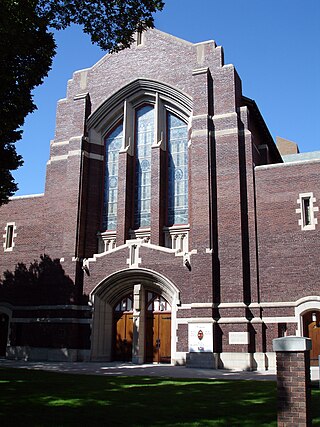
Knox United Church is a designated municipal heritage building at 838 Spadina Crescent East, in the Central Business District, of Saskatoon, Saskatchewan, Canada.
The Landa Residence is a designated Municipal Heritage Property located in the Riversdale, neighborhood of Saskatoon, Saskatchewan, Canada. Thomas E. Heath, Saskatoon's Early Fire Chief lived in the home from 1913–1915. In 1921, the house became the family residence of William and Fanny Landa, the first Jewish family to settle in Saskatoon. William Landa was a carriage maker who immigrated from Russia established the Landa Carriage Works that eventually become the Landa Auto Body Works. The building is of a Pre-World War I Prairie Vernacular architectural style.

















